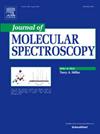Impact of the metal ion and microsolvation on the structure and vibrations in a small model peptide
IF 1.3
4区 物理与天体物理
Q4 PHYSICS, ATOMIC, MOLECULAR & CHEMICAL
引用次数: 0
Abstract
The impact of alkali metal ions (Li+, Na+, and K+) on the structure and vibrations in metal ion-diglycine complexes with up to two water molecules (M+GlyGly-nH2O) is examined using cryogenic infrared action spectroscopy, conformer-specific IR-IR spectroscopy, H2O/D2O isotopic substitution experiments, and scaled, harmonic DFT calculations. While the main conformer is identical for all metal ions for the bare complex (M+GlyGly), the conformers observed upon the addition of water are dependent on the nature of the metal ion and the impact of solvation is distinctly larger for the Li+ than for the K+ ion. The number of solvent molecules needed to change the initial peptide conformation differs between the metal ions and is smaller for Li+ than for the larger metal ions. The comparison of the spectra upon the sequential addition of water reveals how solvation impacts the electric field strength of the metal ions in these clusters. In all cases, the addition of water molecules reduces the strength of the interaction between the metal ion and the peptide and consequently, reduces the strength of the electric field induced in the peptide.

金属离子和微溶剂化对小模型肽结构和振动的影响
碱金属离子(Li+, Na+和K+)对金属离子-二甘氨酸配合物(M+GlyGly-nH2O)的结构和振动的影响通过低温红外作用光谱,构象特异性IR-IR光谱,H2O/D2O同位素取代实验和缩放谐波DFT计算进行了研究。虽然裸配合物(M+GlyGly)中所有金属离子的主构象是相同的,但在加水时观察到的构象取决于金属离子的性质,并且溶剂化对Li+的影响明显大于K+离子。改变初始肽构象所需的溶剂分子数在金属离子之间是不同的,Li+比较大的金属离子要少。对连续加水后的光谱进行比较,揭示了溶剂化如何影响这些簇中金属离子的电场强度。在所有情况下,水分子的加入降低了金属离子与肽之间相互作用的强度,因此,降低了肽中诱导的电场强度。
本文章由计算机程序翻译,如有差异,请以英文原文为准。
求助全文
约1分钟内获得全文
求助全文
来源期刊
CiteScore
2.70
自引率
21.40%
发文量
94
审稿时长
29 days
期刊介绍:
The Journal of Molecular Spectroscopy presents experimental and theoretical articles on all subjects relevant to molecular spectroscopy and its modern applications. An international medium for the publication of some of the most significant research in the field, the Journal of Molecular Spectroscopy is an invaluable resource for astrophysicists, chemists, physicists, engineers, and others involved in molecular spectroscopy research and practice.

 求助内容:
求助内容: 应助结果提醒方式:
应助结果提醒方式:


